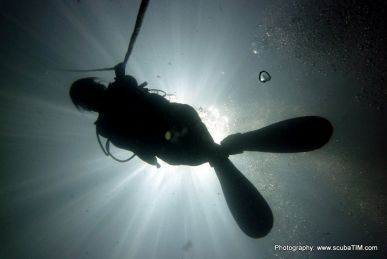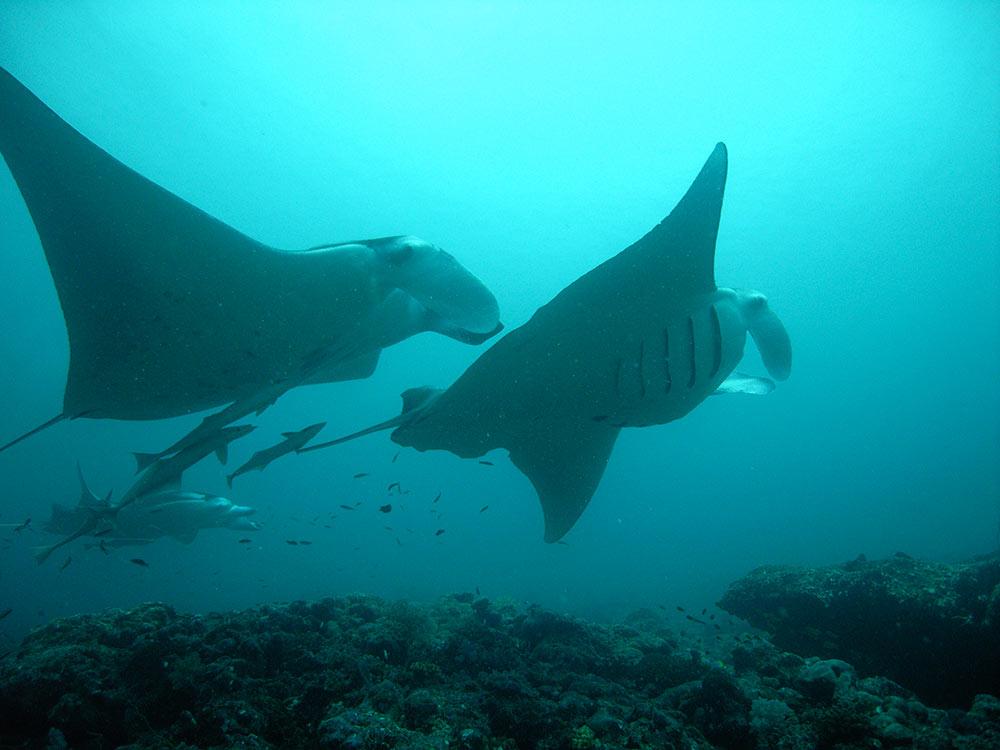Hin Daeng and Hin Muang are not in or near the Similan Islands, but are world-class dive sites in the Andaman Sea off of Thailand's west coast. It is uncommon for boats to travel from The Similans to Hin Daeng/Muang on the same trip, but dive centres in the area take divers there by liveaboard cruise or speedboat day trip throughout the high season. Tours are available from Koh Lanta, Phi Phi and Phuket. Located directly south of Koh Phi Phi, south-southeast of Phuket, and southwest of Koh Lanta, these two pinnacles are out in the open sea. The only reason to go there is to dive. Hin Daeng just about breaches the surface of the water at low tide while Hin Muang, just a hundred or so metres away, remains submerged at all times.
 Diver at Hin DaengThese twin dive sites offer what some people believe to be the best diving in Thailand. Manta Rays (Manta alfredi) and Whale Sharks (Rhincodon typus) are common visitors, and the deep exposed water makes the pinnacles a magnet for healthy marine life. Sea conditions are always favourable for the fish, invertebrates and corals and anemones which live there, with cooler nutrient-rich currents bringing food to the diverse and healthy marine life all year round. However, for divers the conditions can sometimes be challenging, making Hin Daeng and Hin Muang for experienced divers only.
Diver at Hin DaengThese twin dive sites offer what some people believe to be the best diving in Thailand. Manta Rays (Manta alfredi) and Whale Sharks (Rhincodon typus) are common visitors, and the deep exposed water makes the pinnacles a magnet for healthy marine life. Sea conditions are always favourable for the fish, invertebrates and corals and anemones which live there, with cooler nutrient-rich currents bringing food to the diverse and healthy marine life all year round. However, for divers the conditions can sometimes be challenging, making Hin Daeng and Hin Muang for experienced divers only.
Thai fishermen first named Hin Daeng, which means 'Red Rock' in the local language. The first diving groups who came here then found Hin Muang (Purple Rock) just a couple of hundred metres further south. The two pinnacles are actually connected, but at a depth out of the reach of recreational PADI divers. Most dive trips start with the first dive at Hin Muang because it is the deeper of the two dive sites.
Hin Muang resembles a huge loaf of bread. It is approximately 200 metres long and about 20 metres wide in most places. The drop offs are claimed to be the highest or deepest vertical walls in the seas of Thailand. The dive site got its name from the vast covering of purple soft corals which are abundant as far as the eye can see. Although there's lots and lots to see on top of the pinnacle (ridge/plateau), this is where currents can be strong. There's more protection alongside the steep walls, and still plenty of marine life, both large and small. The soft corals are home to tens of thousands of fish and invertebrates, which attract predatory fish from all around. Sometimes these corals are blooming and look extremely healthy, but Mother Nature sometimes decides that it's time for them to die off before coming back again. Therefore, two dives here are never the same. At both dive sites it is impossible to keep an eye out for everything. While there are so many interesting small species to see and photograph, the pinnacles are regularly visited by large sharks and rays. Divers really do need eyes in the backs of their heads.
 Manta Rays (Manta alfredi) Thanks to Lyle Turner at the Global Reef ProjectHin Daeng is the more popular of the dive sites when people mention them, but this could be simply because it's easier to pronounce. In truth, most visitors will dive at both sites, unless there is a compelling reason to stay at one, or away from the other, on the day. Its eastern and northern sides aren't deep and slope away quite smoothly. Divers usually enter the water on the west or south sides and should be careful to watch their depth. In places here it's possible to have up to 60 metres of water below you. There's not a great deal of life attached to this side of Hin Daeng's walls, but don't be put off. While starting deep, it's a good to keep an eye out into the blue. As already mentioned, Whale Sharks and Manta Rays are commonly sighted here, but there is no guarantee. Neither species is dangerous to humans, as they are both filter feeders. Whale Sharks don't appear to care one way or the other of who or what is swimming around them, but Manta Rays are different. Divers who remain in one place and as calm as possible are usually treated to acrobatic loop-the-loops and the rays swimming very near to them. However, those divers who choose to approach the rays and chase after them are more than likely to put them off, spoiling the fun for themselves and the rest of the divers that day. Leopard Sharks (Stegostoma fasciatum – and really Zebra Sharks) can usually be seen resting at depth, but these sharks are common in many Thai waters. More exciting are the Grey Reef Sharks (Carcharhinus amblyrhynchos), which can be mistaken for Blacktip Reef Sharks (Carchaninus melanopterus). It is impossible to list all the fish and other creatures to see at Hin Daeng and Hin Muang, but commonly seen schooling fish are Trevally (Carangidae), Barracuda (Sphyraena), Rainbow Runners (Elagatis bipinnulata), and Fusiliers (Caesionidae). Sometimes it's possible to feel quite disorientated when finding yourself totally surrounded by thousands of fish. On the rock, divers should look for Moray Eels (Gymnothorax), and invertebrates such as octopuses, and lobsters and shrimps. Be careful not to touch anything, as there are a lot of Scorpion Fish (Scorpaenidae) hiding and ready to ambush. They want nothing to do with people, but have venomous spines as a defence mechanism.
Manta Rays (Manta alfredi) Thanks to Lyle Turner at the Global Reef ProjectHin Daeng is the more popular of the dive sites when people mention them, but this could be simply because it's easier to pronounce. In truth, most visitors will dive at both sites, unless there is a compelling reason to stay at one, or away from the other, on the day. Its eastern and northern sides aren't deep and slope away quite smoothly. Divers usually enter the water on the west or south sides and should be careful to watch their depth. In places here it's possible to have up to 60 metres of water below you. There's not a great deal of life attached to this side of Hin Daeng's walls, but don't be put off. While starting deep, it's a good to keep an eye out into the blue. As already mentioned, Whale Sharks and Manta Rays are commonly sighted here, but there is no guarantee. Neither species is dangerous to humans, as they are both filter feeders. Whale Sharks don't appear to care one way or the other of who or what is swimming around them, but Manta Rays are different. Divers who remain in one place and as calm as possible are usually treated to acrobatic loop-the-loops and the rays swimming very near to them. However, those divers who choose to approach the rays and chase after them are more than likely to put them off, spoiling the fun for themselves and the rest of the divers that day. Leopard Sharks (Stegostoma fasciatum – and really Zebra Sharks) can usually be seen resting at depth, but these sharks are common in many Thai waters. More exciting are the Grey Reef Sharks (Carcharhinus amblyrhynchos), which can be mistaken for Blacktip Reef Sharks (Carchaninus melanopterus). It is impossible to list all the fish and other creatures to see at Hin Daeng and Hin Muang, but commonly seen schooling fish are Trevally (Carangidae), Barracuda (Sphyraena), Rainbow Runners (Elagatis bipinnulata), and Fusiliers (Caesionidae). Sometimes it's possible to feel quite disorientated when finding yourself totally surrounded by thousands of fish. On the rock, divers should look for Moray Eels (Gymnothorax), and invertebrates such as octopuses, and lobsters and shrimps. Be careful not to touch anything, as there are a lot of Scorpion Fish (Scorpaenidae) hiding and ready to ambush. They want nothing to do with people, but have venomous spines as a defence mechanism.
It is almost guaranteed that divers will enjoy visiting Hin Daeng and Hin Muang. What is likely, but not guaranteed, is the chance of seeing something large and special, as well as experiencing challenging but exciting diving conditions. To book the best-value dive trips to Hin Daeng & Hin Muang, click here. We offer both speedboat day trips and liveaboard cruises. Although Koh Lanta is nearer to the dive site than the Phi Phi Islands and Phuket, it is easy enough to dive here from any of the three resort locations.



